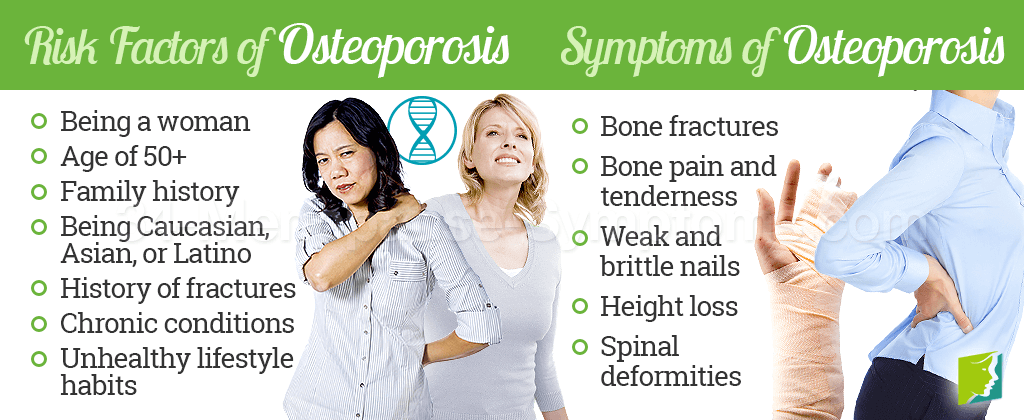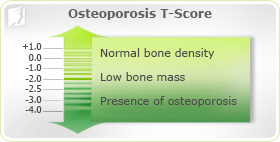Some people are more susceptible to osteoporosis than others. Risk factors can be divided into controllable and uncontrollable factors. For example, a number of the risk factors for osteoporosis are in the control of the individual, such as weight, while other risk factors cannot be controlled, such as family history of osteoporosis. Gender is the most dominant risk factor for developing osteoporosis. Approximately 80% of those who suffer from osteoporosis are women. Continue reading below to find out what other risk factors put certain individuals at a higher risk for developing osteoporosis.
Medications Linked to Bone Loss
Certain medications have been linked to a higher incidence of bone loss, which may lead to osteoporosis. If a woman is taking any of the following medications, it is advised that she consult her doctor about frequent bone density tests to monitor the situation.
Steroid medications - such as prednisone, cortisone, prednisolone, and dexamethasone, which are used for asthma, arthritis, and psoriasis - have all been linked to a loss in bone density.
Selective serotonin reuptake inhibitors (SSRI's) have also been shown to lower bone mineral density among both men and women using them. While this has not been affirmatively linked to osteoporosis, consulting a doctor regarding the possible link is recommended.
Other medications - such as certain blood thinning pharmaceuticals, some anti-seizure medications, and diuretics - have also been linked to bone density loss.
If taking any of the medication outlined above, care must be paid to the possibility of osteoporosis. That does not mean it's necessary to start worrying. Continue reading to learn more of the other risk factors associated with osteoporosis.
Uncontrollable Risk Factors of Osteoporosis
Some risk factors are simply out of the control of the individual and cannot be changed. Even in this case, it's helpful to know if these risk factors are present so preventative or treatment techniques can be administered as soon as possible. Here is a list of unchangeable risk factors for osteoporosis:
Age
Although osteoporosis can affect people of all ages, it becomes far more common as people age, especially once they surpass age 50.
Sex
Osteoporosis is more common in women than men. About four out of five osteoporosis sufferers are women. There are several reasons for this. Women tend to have lighter, thinner bones. Women going through menopause and postmenopausal women are even more susceptible because of diminished amounts of hormones that are necessary for regenerating bone.
Family history
Genetics also play a role in the development of osteoporosis. Those whose family members have osteoporosis are more likely to experience it themselves.
Body type
Women and men with small bones are more likely than larger people to have osteoporosis, but that does not mean heavier or larger people cannot develop it as well.
Race and ethnicity
While osteoporosis affects all races and ethnicities, people who are Caucasian or of Asian or Latino descent are more likely to develop osteoporosis than those of African descent.
History of broken bones
People who have broken one or more bones during their adult years are at a greater risk for osteoporosis. In fact, they may already have low bone density or osteoporosis. A person who has broken a bone as an adult should talk to their healthcare provider about osteoporosis.
Diseases and conditions
Some diseases and conditions can put a person at greater risk of developing osteoporosis, including HIV/AIDS, blood and bone marrow disorders, breast cancer, eating disorders, emphysema, gastrectomy, gastrointestinal bypass procedures, hyperparathyroidism, hyperthyroidism, inflammatory bowel disease, diabetes mellitus, kidney disease, lupus, lymphoma and leukemia, malabsorption syndromes, multiple sclerosis, organ transplants, Parkinson's disease, post-polio syndrome, premature menopause, prostate cancer, rheumatoid arthritis, severe liver disease, spinal cord injuries, stroke, thalassemia, and being underweight.

To learn more about the risk factors that are generally in the control of the individual, continue reading below.
Controllable Risk Factors of Osteoporosis
While the above osteoporosis risk factors are largely out of an individual's control, there are some risk factors that can be controlled or diminished to lessen the chance of osteoporosis. These changeable risk factors are listed below.
Did You Know?
In women over 45 years of age, osteoporosis accounts for more days spent in hospital than many other diseases, including diabetes, heart attack, and breast cancer.
Inactive lifestyle. People who are bedridden, are inactive, or do not exercise are at high risk of osteoporosis. Regular strength-training exercises can help keep a person's bones strong.
Smoking. Smoking is bad for the bones in many ways. Smoking can make it harder to absorb calcium and also lowers estrogen levels.
- Alcohol intake. Drinking heavily can reduce bone formation. In many cases, people who drink too much do not get enough calcium. Drinking may also affect the body's calcium supply. In addition, drinking too much is bad for a person's overall health and can make you more likely to fall if intoxication occurs. Many people fall and break a hip or other bone when they are drunk. Alcohol in smaller amounts, however, does not seem to harm bone health. This usually means no more than two drinks a day.
Continue reading below to find out how a doctor diagnoses osteoporosis.
Osteoporosis Diagnosis
One of the only ways to determine if a person has osteoporosis is with a test called a bone density scan. It measures the amount of minerals in the bones. This scan requires a large machine and must be conducted in a hospital or doctor's office with the right equipment.

Bone density is measured on a point scale, called a "T-score." Normal bone density is registered at a T-score of -1 or higher. If a person's T-score measures between -1 and -2.5, she will probably be diagnosed with osteopenia, a milder form of osteoporosis. A T-score of less than -2.5 indicates osteoporosis.
Now that the many osteoporosis risk factors have been discussed, continue reading to learn about the causes of osteoporosis.
Sources
- Christenson, E.S. et al. (2012). Osteoporosis management in post-menopausal women. Minerva Ginecologica, 64(3), 181-194. Retrieved from http://www.ncbi.nlm.nih.gov/pubmed/22635014
- Cleveland Clinic. (n.d.). Menopause and Osteoporosis. Retrieved May 10, 2016, from https://my.clevelandclinic.org/health/diseases_conditions/hic-what-is-perimenopause-menopause-postmenopause/hic_Menopause_and_Osteoporosis
- New York State Department of Health. (2015). Calcium and Healthy Bones. Retrieved May 10, 2016, from https://www.health.ny.gov/publications/1982.pdf
- Office on Women's Health. (2012). Osteoporosis fact sheet. Retrieved May 10, 2016, from http://www.womenshealth.gov/publications/our-publications/fact-sheet/osteoporosis.html
- University of Maryland Medical Center. (2015). Osteoporosis. Retrieved May 10, 2016, from http://umm.edu/health/medical/altmed/condition/osteoporosis
- U.S. Department of Health and Human Services. (n.d.). 18 Ways Smoking Affects Your Health. Retrieved May 10, 2016, from http://smokefree.gov/health-effects
